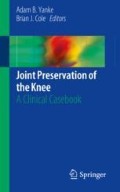Abstract
Due to its multifaceted nature and high rates for revision procedures, failed cartilage repair represents a challenging problem in patients. Prior to performing a revision procedure, it is essential to identify the non-modifiable and modifiable risk factors that accelerate the degradation of primary cartilage repair tissue. Comorbidities can include a patient’s activity status, malalignment, or instability. Since MRI findings may underestimate the true size of a cartilage lesion, data should also be collected from past operative reports and staging arthroscopies. This should be combined with a comprehensive physical exam to assess ligamentous integrity and proper limb alignment in order to optimize the intra-articular environment. When performing osteochondral allograft transplantation for large osteochondral defects, there are a number of important technical strategies and repair options to choose from in order to optimize graft incorporation. For patients who have failed a prior MST and show cystic or osteophytic changes on MRI, it is likely wise to favor OCA. However, in their absence the surgeon may proceed with either OCA or ACI.
Access this chapter
Tax calculation will be finalised at checkout
Purchases are for personal use only
References
Mithoefer K, Williams RJ, Warren RF, Potter HG, Spock CR, Jones EC, Wickiewicz TL, Marx RG. The microfracture technique for the treatment of articular cartilage lesions in the knee. A prospective cohort study. J Bone Joint Surg Am. 2005;87:1911–20.
Solheim E, Hegna J, Øyen J, Harlem T, Strand T. Results at 10 to 14 years after osteochondral autografting (mosaicplasty) in articular cartilage defects in the knee. Knee. 2013;20:287–90.
Meyer MA, et al. Effectiveness of lavage techniques in removing immunogenic elements from osteochondral allografts. Cartilage. 2017;8(4):369–73.
Stoker AM, et al. Bone marrow aspirate concentrate versus platelet rich plasma to enhance osseous integration potential for osteochondral allografts. J Knee Surg. 2018;31(4):314–20.
Chahal J, Thiel GV, Hussey K, Cole BJ. Managing the patient with failed cartilage restoration. Sports Med Arthrosc Rev. 2013;21:62–8.
Gomoll AH, Yoshioka H, Watanabe A, Dunn JC, Minas T. Preoperative measurement of cartilage defects by MRI underestimates lesion size. Cartilage. 2011;2:389–93.
Cook JL, Gomoll AH, Farr J. Commentary on “third-generation autologous chondrocyte implantation versus mosaicplasty for knee cartilage injury: 2-year randomized trial”. J Orthop Res. 2016;34:557–8.
Bentley G, Biant LC, Vijayan S, Macmull S, Skinner JA, Carrington RWJ. Minimum ten-year results of a prospective randomised study of autologous chondrocyte implantation versus mosaicplasty for symptomatic articular cartilage lesions of the knee. J Bone Joint Surg Br. 2012;94:504–9.
Gudas R, Gudaitė A, Pocius A, Gudienė A, Čekanauskas E, Monastyreckiene E, Basevičius A. Ten-year follow-up of a prospective, randomized clinical study of mosaic osteochondral autologous transplantation versus microfracture for the treatment of osteochondral defects in the knee joint of athletes. Am J Sports Med. 2012;40:2499–508.
Pestka JM, Bode G, Salzmann G, Sudkamp NP, Niemeyer P. Clinical outcome of autologous chondrocyte implantation for failed microfracture treatment of full-thickness cartilage defects of the knee joint. Am J Sports Med. 2012;40:325–31.
Zaslav K, Cole B, Brewster R, DeBerardino T, Farr J, Fowler P, Nissen C. A prospective study of autologous chondrocyte implantation in patients with failed prior treatment for articular cartilage defect of the knee: results of the Study of the Treatment of Articular Repair (STAR) clinical trial. Am J Sports Med. 2008;37:42–55.
Minas T, Gomoll AH, Rosenberger R, Royce RO, Bryant T. Increased failure rate of autologous chondrocyte implantation after previous treatment with marrow stimulation techniques. Am J Sports Med. 2009;37:902–8.
Minas T, Ogura T, Headrick J, Bryant T. Autologous chondrocyte implantation “Sandwich” technique compared with autologous bone grafting for deep osteochondral lesions in the knee. Am J Sports Med. 2017;16:036354651773800.
Gracitelli GC, Meric G, Pulido PA, McCauley JC, Bugbee WD. Osteochondral allograft transplantation for knee lesions after failure of cartilage repair surgery. Cartilage. 2014;6:98–105.
Gracitelli GC, Meric G, Briggs DT, Pulido PA, McCauley JC, Belloti JC, Bugbee WD. Fresh osteochondral allografts in the knee: comparison of primary transplantation versus transplantation after failure of previous subchondral marrow stimulation. Am J Sports Med. 2015;43:885–91.
Rosa D, Di Donato S, Balato G, D'Addona A, Smeraglia F, Correra G, Di Vico G. How to manage a failed cartilage repair: a systematic literature review. Joints. 2017;05:093–106.
Kon E, Mutini A, Arcangeli E, Delcogliano M, Filardo G, Nicoli Aldini N, Pressato D, Quarto R, Zaffagnini S, Marcacci M. Novel nanostructured scaffold for osteochondral regeneration: pilot study in horses. J Tissue Eng Regen Med. 2010;4:300–8.
Kon E, Robinson D, Verdonk P, Drobnic M. A novel aragonite-based scaffold for osteochondral regeneration: early experience on human implants and technical developments. Injury. 2016;47:S27.
Kon E, Filardo G, Shani J, Altschuler N, Levy A, Zaslav K, Eisman JE, Robinson D. Osteochondral regeneration with a novel aragonite-hyaluronate biphasic scaffold: up to 12-month follow-up study in a goat model. J Orthop Surg Res. 2015;10:81.
Author information
Authors and Affiliations
Corresponding author
Editor information
Editors and Affiliations
Rights and permissions
Copyright information
© 2019 Springer Nature Switzerland AG
About this chapter
Cite this chapter
Riff, A.J., Gomoll, A.H. (2019). Revision Cartilage Treatment. In: Yanke, A., Cole, B. (eds) Joint Preservation of the Knee. Springer, Cham. https://doi.org/10.1007/978-3-030-01491-9_13
Download citation
DOI: https://doi.org/10.1007/978-3-030-01491-9_13
Published:
Publisher Name: Springer, Cham
Print ISBN: 978-3-030-01490-2
Online ISBN: 978-3-030-01491-9
eBook Packages: MedicineMedicine (R0)

